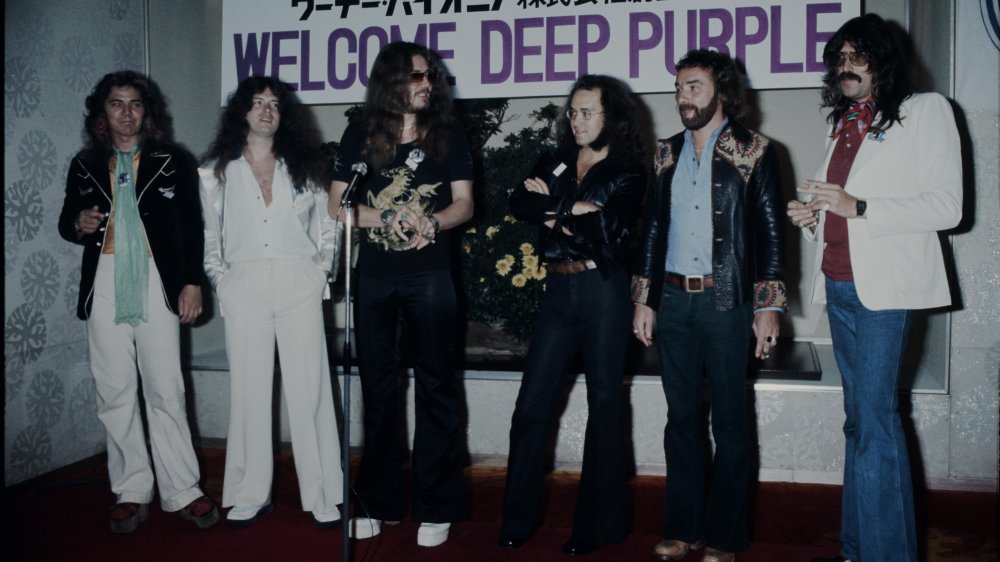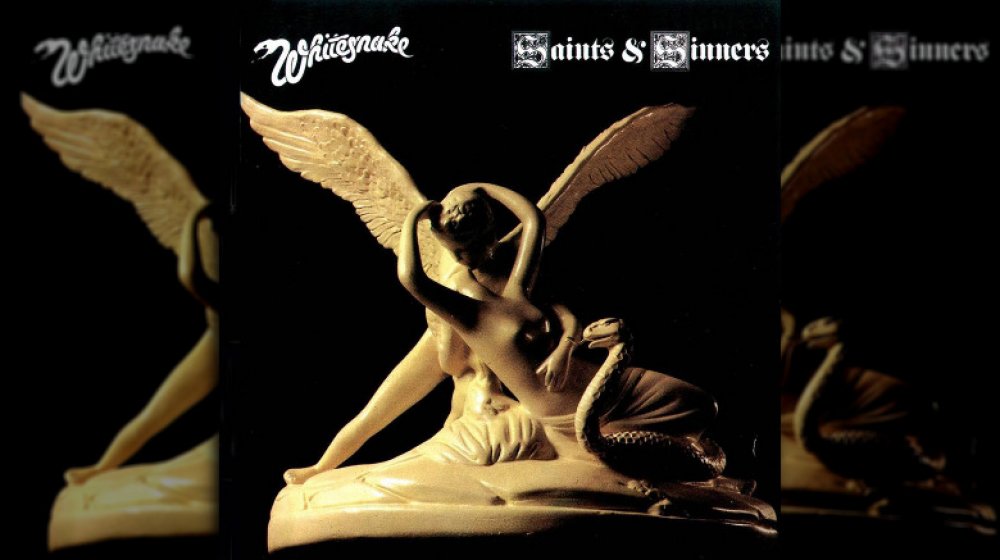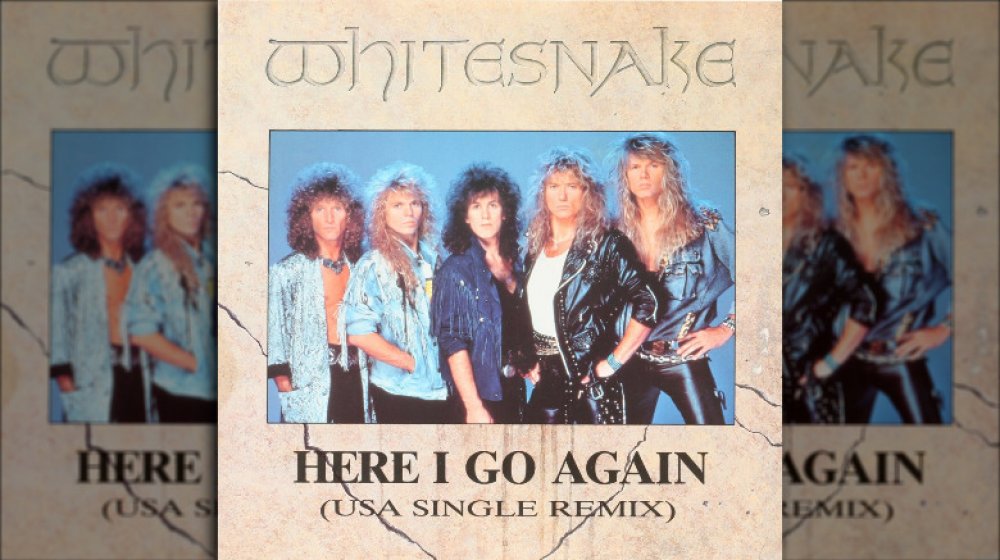The Untold Truth Of Whitesnake
Whitesnake. Admit it, right now you're picturing Tawny Kitaen doing cartwheels on top of jaguars while wearing a gauzy white negligee. Whitesnake is 1987 all the way — ironic, since lead singer David Coverdale (who essentially is Whitesnake) got his start in the 1970s with classic rock legends Deep Purple.
Whitesnake's breakthrough in 1987 with the megahit "Here I Go Again"— perhaps the catchiest hard rock song of all time — made them a legendary band. For many, their image of the band is stuck in that moment of time, with Coverdale overly tan and dressed in what can only be described as the most Miami Vice, 1980s suit ever tailored. For others, Whitesnake is simply one of many 80s hard rock bands lifting riffs from Led Zeppelin and getting by on glossy videos starring people as good-looking at Kitaen. A few years later, musical tastes changed and Whitesnake faded from memory.
But in a world where even the most successful bands last a few years, Whitesnake has a fascinating, unexpectedly complex history that stretches over four decades. The untold truth of Whitesnake includes heartbreak, artistic reinvention, natural disasters, and tons of behind-the-music drama. Here are a few things you probably don't know about David Coverdale's band.
Whitesnake was a slow burn success
Whitesnake wasn't exactly an overnight sensation. David Coverdale formed the band after leaving Deep Purple. He launched a brief solo career, releasing two albums. As Louder notes, he then formed a band he initially called David Coverdale's Whitesnake, which he quickly (and wisely) shortened to just Whitesnake. The band released its first album, Trouble, in 1978.
As reported by Music Aficionado, the band proceeded to release five more albums to modest success in the U.K. and Europe — and a distinct lack of success in the United States. The band's sound was initially out of step with what was happening in rock music at the time. It was a very bluesy, rough 1970s sound that simply wasn't in vogue in a world where punk rock and new wave were dominating the rock charts.
Coverdale, to his credit, understood this and worked to change the band's sound. He switched up the folks in his band and began writing songs that leaned more into the heavy metal sound that was popular at the time. Whitesnake's sixth album, Slide It In, became their initial modest breakthrough in the U.S. — six years after their formation. They mounted a massive tour and got a few singles on the charts, and the stage was set for the band to take a massive leap forward with their next project — which is exactly what happened.
Whitesnake wrote a song for B.B. King
Whitesnake doesn't seem like a band that would be mentioned in the same sentence as blues legend B.B. King. The differing musical styles, cultural backgrounds, and fashion sense would seem to prove that these were two completely opposite worlds that would never mix.
But it's important to note that band founder David Coverdale came out of a blues-inspired, 1970s rock tradition. So it's not entirely crazy to learn that one of Whitesnake's signature hit songs was originally written with the intention of giving it to King to record.
As Coverdale told Ultimate-Guitar.com, Whitesnake guitarist Bernie Marsden had interviewed King for a British magazine in 1978. At the end of the interview, King invited Marsden and Whitesnake to write a song for him — and the band was excited to do so. Whitesnake's sound was still more blues-rock than the heavy metal style they would develop later, so this makes more sense than originally thought.
The song the band came up with was "Fool For Your Loving." If you think that sounds familiar, that's because it appeared on their 1980 album Ready an' Willing (and was re-recorded and re-released in 1989). The band realized that the song was actually quite good — so they changed their minds about offering it to King and kept it for themselves. This turned out to be a good move, as the Official Charts Company notes the song hit No. 13 in 1980 and No. 43 in 1989.
Whitesnake fell apart in 1982
If you're just looking at Whitesnake's release history, you'd think the band has existed smoothly and without controversy at least until 1989, when the band took an eight-year break between albums. But the fact is that Whitesnake essentially broke up in 1982.
As Louder reports, there was a lot going on for the band that year. David Coverdale had launched an effort to update and adjust the band's sound, moving away from the bluesy early material and towards a more hard rock approach. The band wasn't getting along, and while their albums had sold well in Europe and the U.K., they hadn't managed a breakthrough in the all-important U.S. market.
Then, Coverdale's daughter, Jessica, contracted bacterial meningitis. The lead singer decided to put the band on hold while he went home to look after her. The band, however, saw it differently: Guitarist Bernie Marsden, drummer Ian Paice, and bassist Neil Murray say they thought Coverdale was acting like he was Whitesnake and treating them as employees, not co-equal members. So they walked out.
That might have been fine with Coverdale. He hired new band members and reshaped the band into a heavy metal outfit whose next album, 1984's Slide It In, would be the breakthrough he'd been looking for since 1978.
Whitesnake couldn't have done it without David Geffen
When Whitesnake formed in 1978, it had a very 1970s rock sound. Which makes sense, since founder David Coverdale had cut his teeth as the lead singer of Deep Purple from 1973 to 1976. The two solo albums Coverdale released after Deep Purple's breakup were also understated blues-rock albums. As noted by Louder, someone who discovered Whitesnake based on their mid-1980s breakthrough wouldn't recognize the musical style found on their earlier records.
One of the main influences over Whitesnake's change in style and sudden success after years of frustration was music titan David Geffen. The band had switched U.S. labels to Geffen in 1982. In 1984, Whitesnake released what would be their first huge success in America, Slide It In. As Coverdale told Louder, Geffen was the person who persuaded him that his blues-rock approach was dated, and that if he wanted to be a superstar, he had to change with the times.
Coverdale took the advice to heart. He moved to America, realizing that if he wanted to conquer that market he had to live there. Over the course of those first two Geffen albums, Whitesnake became a whole new band (literally, as Coverdale fired almost everyone in 1982 and had a whole new lineup for Slide It In). And it worked. As Coverdale said, "... it worked astonishingly well. I sold embarrassingly large amounts of records in a three- to five-year period."
Whitesnake's biggest album almost didn't happen
After finally tasting chart success in the U.S. with 1984's Slide It In, Whitesnake was poised for huge success. American radio had finally given them significant airplay, a world tour had cemented a fan base, and their U.S. music label, Geffen, was very supportive of the band.
David Coverdale hired a new guitarist, John Sykes, and the two began writing songs in 1985 while Coverdale, always reinventing the band, looked around for a new drummer and other personnel. Things were going very well — Coverdale had resurrected an old demo from his Deep Purple days, a song that would become their huge hit "Still of the Night." And a song Ultimate-Guitar.com reports he'd originally written for Tina Turner, "Is This Love," would also be a smash for the band. With the new lineup finally in place, the band headed into the studio.
And then tragedy struck: As Louder reports, Coverdale came down with a sinus infection that prevented him from singing for a full eight months as he recovered. As Ultimate Classic Rock reports, the infection was so bad he was given 50-50 odds of ever singing again and needed surgery to recover. Even worse, guitarist Sykes attempted to push Coverdale out of the band and replace him with another singer. When Coverdale re-entered the studio, the music tracks had been recorded — but the band had been fired.
Whitesnake's biggest hit is about a dying marriage
For many casual fans, "Here I Go Again" is a catchy rock song about moving forward and pursuing restless dreams. The song was a smash top-ten hit for Whitesnake in 1987, and the music video starring Tawny Kitaen is an iconic image of the late 1980s.
But as Society of Rock notes, the truth about "Here I Go Again" is a lot darker. The song had originally appeared on Whitesnake's 1982 album Saints & Sinners. According to Consequence of Sound, David Coverdale wrote the song about his crumbling marriage to Julia Borkowski, who he'd married in 1974. The couple divorced in 1978, and it was a dark time for Coverdale. The couple had just welcomed their daughter, Jessica, into the world and had traveled to Portugal for a vacation. Coverdale found himself sleeping in a separate bedroom. As he put it, he and Borkowski "went from being the best of friends to not being the best of friends."
It was in this frame of mind that he wrote his most successful song. It makes sense if you pay attention to the lyrics: "Though I keep searchin' for an answer / I never seem to find what I'm lookin' for / Oh Lord, I pray you give me strength to carry on." Once you see it, you can never hear the song in the same way again.
It took three tries to get Whitesnake's biggest hit
Every hit song has a story behind it. Sometimes that story is almost magical in its simplicity, like Keith Richards waking up to discover he'd recorded the riff for "(I Can't Get No) Satisfaction" at some point during the night, with no memory of it. Sometimes it's a little more tortured than that. Whitesnake's biggest hit, "Here I Go Again," is a prime example.
Originally written by David Coverdale and guitarist Bernie Marsden in the late 1970s and inspired by Coverdale's divorce, the song originally appeared on Whitesnake's 1982 album Saints & Sinners. This version is a bluesy, subdued rendition that Coverdale never liked. According to Ultimate Classic Rock, that version of the band was already in the process of breaking up, and Coverdale referred to Saints & Sinners as his "contractual-obligation album."
The song was re-recorded for the band's 1987 self-titled album, Whitesnake, with a more modern sound (for the time), complete with lush keyboards and huge drums. But the song's journey wasn't over. The band's label, Geffen, thought the album version of the song wasn't radio-friendly enough, so Coverdale went back into the studio to record a third version of the song, with a different arrangement and sound mix.
The song went on to hit No. 9 on the charts, became the band's signature song, and launched them into the stratosphere of rock acts. It just took three tries and nearly ten years.
Tawny Kitaen was a happy accident
The image of a lingerie-clad Tawny Kitaen cavorting on top of two jaguars in the music video for Whitesnake's "Here I Go Again" is one of the most iconic moments of the 1980s. But it was actually supposed to be another very famous face from the 1980s doing those impressive cartwheels.
As Consequence of Sound reports, David Coverdale and Kitaen already knew each other when the music video was being planned — but Kitaen wasn't originally cast in the role. Instead, supermodel Claudia Schiffer was supposed to appear. At the time, Schiffer was red hot as the face of the iconic Guess? Jeans advertising campaign.
One evening, Coverdale and Kitaen were out to dinner when Coverdale received an urgent text message from the label — Schiffer had been forced to drop out of the video. He took Kitaen with him to the meeting with the video's director, Marty Callner. The moment Callner saw Kitaen, he asked if she'd take Schiffer's place — and naturally Kitaen said yes. Coverdale brought in Paula Abdul to work with Kitaen on her moves, but Abdul reportedly told him Kitaen didn't need any help.
That decision had real-life consequences for Coverdale and Kitaen, who married two years later and divorced less than two years after that.
Whitesnake's Here I Go Again video is a lie
Rock and roll is a notoriously chaotic business, and Whitesnake epitomizes that. There are only two constants in the history of Whitesnake: lead singer David Coverdale and an almost entirely new lineup of musicians every few years. In 1982, for example, Coverdale fired most of the band and reformed it with a new direction. And in 1987, he did pretty much the same thing — before the album Whitesnake was even released.
As Louder reports, the recording sessions for Whitesnake were interrupted for almost a year when Coverdale came down with a serious sinus infection that required surgery. During this long down time, guitarist John Sykes actually tried to get Coverdale to give up lead singing duties and act as a producer on the album. Coverdale didn't appreciate this attempt to remove him from his own band. As a result, by the time Coverdale was well enough to lay down the vocal tracks, the band had largely been fired.
According to Ultimate Classic Rock, that means that the musicians who appear in the classic video for "Here I Go Again" didn't actually play on the record. With one exception: Guitarist Adrian Vandenberg had worked in the studio on the album. Everyone else was miming to someone else's playing.
Whitesnake's master tapes are gone
When a band goes into a recording studio to record an album, there's a process. Different bands record differently — some work in isolation, recording individual tracks that are mixed together later, and some work as a live unit, with the mix being performed in real time. But one thing is always true: The end result are pristine master tapes that can be used at a later time to remix every song. These master tapes are an invaluable asset for a recording artist.
As Rolling Stone notes, in 2008 the Universal Music Group suffered a fire at a location where a vault containing the master tapes for many mega-selling musicians and bands were stored. As The New York Times reports, the fire destroyed the master tapes for hundreds of bands, including Bryan Adams, Styx, Nirvana — and Whitesnake.
Considering that Whitesnake has a long history of repurposing and remixing their music, this is a terrible loss for the band. Without the master tapes, it's impossible to go back and remaster the songs or make any substantive tweaks to the compositions at all. While the officially released versions of the songs can still be reproduced, the loss of the masters is a disaster — and has prompted a class action lawsuit against Universal, which kept the list of affected artists secret for years.
Whitesnake has had 12 lead guitarists
If you're a musician seeking job security, stay away from Whitesnake. Over the course of 42 years, the band has had 40 members aside from David Coverdale, who has been the only member to appear on every single album. In fact, it's not uncommon to find a musician who toured with the band but never appeared on a recording, or the other way around.
This is because Coverdale has always been willing to change the band's sound and approach when he thinks it's necessary, which often requires fresh blood — and possibly because he's difficult to work with. According to Louder, the entire band revolted against Coverdale's leadership in 1982, resulting in a complete purge and a new lineup.
What's really remarkable is how many top-notch musicians have had their Whitesnake moment. People like legendary drummer Cozy Powell have made their mark in the band, after all. But as Ultimate-Guitar points out, the most remarkable statistic is the fact that the band has had 12 lead guitarists in its time, including absolute legends Vivian Campbell, Steve Vai, and John Sykes. If you're going to re-arrange the lineup of your band every few years, after all, you might as well hire Hall of Fame-caliber musicians.
Whitesnake's 1987 breakthrough album saved David Coverdale from bankruptcy
You might think that by 1985 David Coverdale was pretty rich. At the age of 22, he became the lead singer of one of the biggest bands in the world, Deep Purple. Then he launched a solo career and finally put together Whitesnake, a band that by that point had released six albums, toured the world, and enjoyed not inconsiderable success around the world.
And yet, as reported by Blabbermouth, Coverdale was nearly $3 million in debt by the time he was working on the album that would become 1987's Whitesnake. Coverdale blames poor advice from the band's management over the years. As Music Aficionado reports, Coverdale was so desperate to get away from his manager in the early 1980s, he signed an agreement that assigned all the band's debt to Coverdale personally in exchange for being released from his contract.
It all worked out. Whitesnake's 1987 album Whitesnake was a massive hit. Ultimate Classic Rock reports that although the album only made it to No. 2 on the charts, it charted for months. It has so far sold about 15 million copies worldwide, and Coverdale went from being a debt millionaire to being an actual millionaire in about three months.












